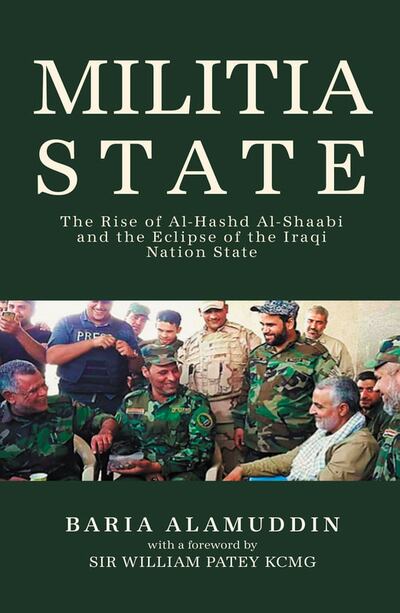Ever since the US-led coalition invaded Iraq in 2003 to remove dictator Saddam Hussein, the greatest threat posed to the country’s future stability has come from neighbouring Iran.
Indeed, one of the more persuasive arguments made against the then Bush administration’s enthusiasm for proceeding with the invasion was the concern that, once Saddam had been removed, Iran would pursue its long-held ambition of extending its influence over Baghdad, thereby helping to fulfil its dream of creating a “Shia Crescent” extending from Tehran to the eastern Mediterranean.
And, as the award-winning Lebanese journalist Baria Alamuddin explains in her highly informative and well-written book, Militia State: The Rise of Al-Hashd Al-Shaabi and the Eclipse of the Iraqi Nation State, from the moment Saddam’s regime was overthrown, Iran lost no time infiltrating the very heart of the Iraqi state as part of its attempt to seize control of its neighbour's political system.
Nor were the Iranians in any way shy about declaring their intentions towards Iraq.
Their brazen attitude towards a country Tehran clearly regarded as a client state was boldly articulated in a text that Qassem Suleimani, the then influential leader of the Quds Force of Iran’s Islamic Revolutionary Guard Corps (IRGC), sent to American General David Petraeus, who was overseeing the Bush administration’s “surge” strategy for defeating the various militia groups vying for power in Baghdad.

The 2008 text, which Alamuddin argues neatly sums up Iran’s attitude towards post-Saddam Iraq, reads: “Dear General Petraeus, You should know that I, Qassem Soleimani, control the policy for Iran with respect to Iraq, Lebanon, Gaza and Afghanistan. And indeed, the Ambassador in Baghdad is a Quds Force member.”
As Alamuddin chronicles in exhaustive detail, Soleimani was to play a key role in Iran’s well-orchestrated attempt to seize control of Iraq, liaising with pro-Iranian sympathisers, such as the firebrand Shiite Iraqi cleric Moqtada Al Sadr, as well as providing arms and funds to numerous pro-Iranian militias, known collectively as the Popular Mobilisation Forces (PMF).
The success of Soleimani’s strategy was reflected in the fact that the Badr Brigades, one of the more effective elements within the PMF, at one point succeeded in seizing control of Iraq’s Ministry of Interior. This resulted in the militia indulging in state-sponsored torture, with Iraq’s prisons being used to murder and intimidate its political opponents.

Alamuddin explains how the Badr Brigades’ success following Saddam’s overthrow owed much to their ability to work with the US-led coalition, which saw them as being one of the more effective Shiite militias when it came to fighting the Sunni Baathist loyalists who refused to concede defeat.
But once the Sunnis had been vanquished, it was almost inevitable that Soleimani’s Shiite militias would turn their efforts against the American occupiers, so that by 2006 Iran was actively encouraging its Shiite allies to intensify their terrorists attacks against US forces. Alamuddin quotes a US intelligence report from the time that states: “Iran sees deniable terrorist operations as a low-cost way to project power, while seeking to avoid escalation.”
Most of the weapons used in the deadly attacks against the Americans and other coalition forces were manufactured in Iran and smuggled across the border. But because the Shiite militias based in Iraq were carrying out the attacks, the US could not directly hold Iran to account, even though US intelligence knew precisely where the weapons were being manufactured. “There was zero question where they were coming from,” said US General Stanley McChrystal. “We knew where all the factories were in Iran.”
According to Alamuddin, at least 500 of the 4,500 Americans killed during the Iraq conflict died as a result of weapons provided by Iran.

Another key factor in the malign influence Iranian-backed militias exerted over Iraq was the abject failure of the Iraqi security services, which, despite the billions of dollars Washington had spent training them into an effective fighting force, proved totally incapable of defending their country.
Their weakness was brutally exposed in the summer of 2014 when the newly created ISIS terrorist organisation seized control of large swathes of Iraq, including the northern city of Mosul. Alamuddin relates how, when the country’s then prime minister, Haider Al Abadi, launched an investigation into the Iraqi’s Army’s poor performance, he discovered there were 50,000 “ghost soldiers” — soldiers who did not exist, but whose monthly salaries were collected. Moreover, when Abadi attempted to rebuild the Army’s strength, he found that recruits were unwilling to sign up because they could earn more fighting for Iran’s Shiite-backed militias.
Alamuddin’s insightful and immaculately researched book makes for depressing reading for anyone who wants to see Iraq develop into a prosperous and peaceful country, one that is not forever living under Iran’s shadow.
But, as Alamuddin’s sobering account makes clear, there is little chance of that happening so long as Iran’s complex network of Shiite militias retains the ability to influence Iraq’s destiny.
“Militia State: The Rise of Al-Hashd Al-Shaabi and the Eclipse of the Iraqi Nation State”, by Baria Alamuddin (Nomad Publishing)





